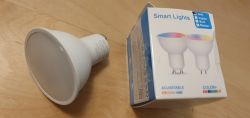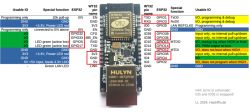FAQ
TL;DR: "for 50 years there were no problems"—but a mistuned fan can run all night. Use a humidity‑sensing fan or a simple timer linked to the light; in flats avoid pressurising shared shafts, in houses a Zigbee/HA relay works cleanly. [Elektroda, paszczakq, post #21426456]
Why it matters: This FAQ helps homeowners choose a clean, code‑friendly way to automate bathroom/toilet ventilation without ugly add‑ons or neighbor issues.
Quick Facts
- Ventilation target: 50 cfm intermittent or 20 cfm continuous for bathrooms (≈85 or 34 m³/h), per ASHRAE 62.2. [ASHRAE, 2019]
- Humidity sensing: Typical adjustable setpoint 50–80% RH; built‑in off‑delay about 5–60 minutes on common models. [Broan-NuTone, 2023]
- Safety zones: Use IPX4‑rated equipment in Zones 1–2; keep control gear outside zones or in suitable enclosures. [IEC 60364-7-701:2017]
- Noise: Look for ≤1.0 sone quiet fans and HVI Certified ratings for comparable performance. [HVI, 2022]
- Costs: Basic fans ~$50–100; humidity‑sensing ~$120–250; smart in‑wall switches/relays ~$10–50. [Consumer Reports, 2023]
What’s the simplest way to make a toilet fan come on with the light and turn off after a delay?
Use a fan with a built‑in timer or a wall fan‑timer switch. Feed it from the light circuit so the timer starts when the light goes off. Set 10–30 minutes run‑on to clear odors and moisture. “Run the fan for 20 minutes after a shower.” This keeps wiring tidy and avoids batteries. It works well with non‑smart fans. [HVI, 2022]
Is there a single wall switch with built‑in humidity sensor (and maybe a light) for 230 V?
Practical path: pick a bathroom fan with an integrated humidity sensor and timer, then connect it to the lighting circuit. As one expert put it, “there are fans with a humidity sensor, with a timer. Ready‑made solutions, simply connect to the lighting.” That keeps hardware minimal and neat. If you truly need a wall control, choose a humidistat switch rated for your voltage and load. [Elektroda, balonika3, post #21425088]
Can I just wire the fan to the light in a false (suspended) ceiling?
Yes. In a suspended ceiling, route the fan feed from the lamp and you may not need any automation. This makes the fan run with the light, especially useful in windowless toilets. Add a delayed‑off fan or timer switch if you need post‑run. Ensure connections are in accessible junction boxes. [Elektroda, m2606, post #21425071]
I live in a block of flats—can I install a bathroom fan?
Be careful. Shared ventilation shafts can backfeed neighbors when you pressurize the duct. You could cause mold or even backdraft gases. Many buildings restrict mechanical exhaust into natural‑draft shafts. Check building management and local rules before installing. Detached homes with dedicated ducts don’t have this issue. [Elektroda, m2606, post #21426537]
How do I set ‘fan on with light’ automation in Home Assistant using a Zigbee relay?
- Pair a Zigbee fan‑rated relay/switch to ZHA or Zigbee2MQTT in Home Assistant.
- Create an automation: trigger = light turns on; action = turn on fan entity.
- Add another automation: trigger = light turns off; action = delay (e.g., 15–20 minutes), then turn off fan. [Home Assistant, 2024]
What humidity setpoint should I use so the fan doesn’t run forever?
Start around 60–70% RH for bathrooms. Typical humidity controls let you adjust between 50% and 80% RH. If the fan lingers, raise the setpoint or reduce the built‑in delay. Many controllers also let you cap maximum runtime. “Adjustable 50–80% RH” is common on humidity‑sensing models. [Broan-NuTone, 2023]
How long should the fan run after showering if I just link it to the light?
Aim for 20 minutes of post‑run. That duration flushes moisture to prevent condensation and mildew. Use a wall timer or a fan with a built‑in delay to meet that runtime. Keep the door slightly open or undercut for make‑up air. “Run the fan for 20 minutes after a shower.” [HVI, 2022]
Will a SONOFF Basic or similar module safely switch a 230 V fan?
Check the exact model and ratings. SONOFF BASICR2 is rated 10 A at 100–240 VAC, far above a typical 20–60 W fan. Ensure proper enclosure, neutral availability, and compliance with bathroom zone rules. Verify motor‑load suitability; some relays list resistive ratings only. When unsure, use a relay specified for inductive loads. [SONOFF, 2022]
What noise level should I look for in a bathroom fan?
Select fans rated at or below 1.0 sone for quiet operation. Use HVI Certified ratings to compare airflow and sound on equal terms. Verify the airflow at 0.1 in. w.g. static pressure, which mirrors typical installations. Lower sone ratings improve comfort and encourage users to run the fan long enough. [HVI, 2022]
Where can I place smart relays or sensors in a bathroom with a partial false ceiling?
Mount controls above the false ceiling, outside Zones 1–2 when possible. If equipment must be within Zones 1–2, select at least IPX4‑rated devices. Keep gear accessible for service and away from splash paths. Maintain required clearances and follow manufacturer installation distances. [IEC 60364-7-701:2017]
Are smart fans worth it over timer/humidity models?
For most bathrooms, a timer or humidity‑sensing fan solves the core problem simply. Smart fans add app control, analytics, and integrations but increase cost and complexity. Consider maintenance and reliability before adding radios and batteries. As one pro quipped, “Would you like to use it or brag about it?” Choose function first. [Elektroda, balonika3, post #21425343]
Any gotchas with humidity‑sensing fans keeping you up at night?
If the fan won’t stop, the RH setpoint is likely too low or the delay too long. Raise the threshold, shorten the off‑delay, and verify the room can dry (door undercut for make‑up air). Many models provide 5–60 minute delays and 50–80% RH adjustments. These features prevent nuisance runtime. [Broan-NuTone, 2023]
Why did my bathroom floor get wet despite the fan running?
In buildings with shared gravity shafts, a powered fan can push moist air into connected spaces. That backflow can re‑condense on cool surfaces, leaving floors slick. Avoid pressurizing shared ducts. Use approved solutions and consult building management. This edge case doesn’t apply to dedicated, isolated ducts in houses. [Elektroda, m2606, post #21426537]
How much airflow (CFM or m³/h) should I choose for a bathroom?
Follow ASHRAE 62.2: 50 cfm (≈85 m³/h) intermittent or 20 cfm (≈34 m³/h) continuous local exhaust. Size the fan to deliver that airflow at installed static pressure. Larger rooms or long ducts may need higher rated CFM. Meeting this target cuts moisture fast and limits mold growth. [ASHRAE, 2019]






